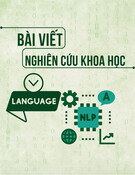
P-ISSN 1859-3585 E-ISSN 2615-9619 https://jst-haui.vn LANGUAGE - CULTURE
Vol. 61 - No. 2 (Feb 2025) HaUI Journal of Science and Technology
59
EXPLORING COMMUNICATIVE COMPETENCE DEVELOPMENT
IN EOP CLASSROOMS: A CASE STUDY FROM A VIETNAMESE
UNIVERSITY
PHÁT TRIỂN NĂNG LỰC GIAO TIẾP TRONG LỚP HỌC TIẾNG ANH ĐỊNH HƯỚNG NGHỀ NGHIỆP:
NGHIÊN CỨU TRƯỜNG HỢP TẠI MỘT TRƯỜNG ĐẠI HỌC VIỆT NAM
Dang Thi Minh Tam1,*, Nguyen Thi Khanh Linh1,
Hoang Thi Thu Thuy2
DOI: http://doi.org/10.57001/huih5804.2025.037
ABSTRACT
This study investigates the development of communicative competence in English for Occupational Purposes (EOP)
classrooms at a university in Vietnam.
Focusing on teachers' practices, the research explores how communicative competence is fostered using Communicative Language
Teaching (CLT) principles.
Utilizing a qualitative approach, data were collected from 13 rec
orded EOP classes. Data was analyzed from teaching classroom activities, instructional materials,
and in-depth interviews with teachers. The findings indicate that CLT principles were widely applied in EOP classrooms to develop co
mmunicative competence.
However, challenges persist, such as the diversity of student proficiency levels and the limitations of pre-
designed teaching materials. The study emphasizes the
need for improvement in teaching materials and adopts different teaching approaches. These findi
ngs provide practical recommendations to enhance EOP
teaching practices and better equip students for workplace communication.
Keywords: Communicative competence, English for Occupational Purpose (EOP), Communicative Language Teaching (CLT).
TÓM TẮT
Nghiên cứu này tìm hiểu việc phát triển năng lực giao tiếp trong các lớp học Tiếng Anh định hướng nghề nghiệp (EOP) tại một trường đại học ở Việ
t Nam.
Nghiên cứu sử dụng các nguyên tắc của cách tiếp cận Giảng dạy Ngôn ngữ Giao tiếp (CLT) để đánh giá việc phát triển năng lực giao tiếp trong lớp học. Dữ liệ
u
định tính chính được thu thập từ 13 tiết học Tiếng Anh EOP. Ngoài ra còn có dữ liệu bổ trợ được từ phân tích tài liệu giảng dạy và phỏng vấn sâu với giả
ng viên.
Kết quả cho thấy, các nguyên tắc CLT được áp dụng rộng rãi trong lớp học EOP nhằm phát triển năng lực giao tiếp, tuy nhiên vẫn tồn tại một số thách thứ
c như
sự không đồng nhất về trình độ của sinh viên và một số hạn chế của tài liệu giảng dạy. Nghiên cứu nhấn mạnh sự cần thiết cải thiện tài liệu giảng dạy và áp dụ
ng
các phương pháp khác nhau trong lớp học.
Từ khóa: Năng lực giao tiếp, Tiếng Anh định hướng nghề nghiệp (EOP), giảng dạy ngôn ngữ theo đường hướng giao tiếp (CLT).
1School of Languages and Tourism, Hanoi University of Industry, Vietnam
2University of South Australia, Australia
*Email: dangthiminhtam.haui@gmail.com
Received: 05/11/2024
Revised: 19/12/2024
Accepted: 27/02/2025
1. INTRODUCTION
English has become a global lingua franca,
indispensable across academic and professional sectors.
As the world becomes increasingly interconnected,
proficiency in English is no longer just an advantage but
a requirement for career success in many fields [1].
Various instructional methodologies have emerged in
response to this growing demand, with CLT leading the

VĂN HÓA https://jst-haui.vn
Tạp chí Khoa học và Công nghệ Trường Đại học Công nghiệp Hà Nội Tập 61 - Số 2 (02/2025)
60
NGÔN NG
Ữ
P
-
ISSN 1859
-
3585
E
-
ISSN 2615
-
961
9
way. Unlike traditional methods focusing on rote
memorization and grammar drills, CLT prioritizes active,
meaningful language use, helping learners develop
communicative competence - the ability to use language
effectively and appropriately in real-world contexts [2].
CLT focuses on developing learners' communicative
competence through authentic texts and real-life
language use [3].
Within the broader framework of English for Specific
Purposes (ESP), the branch of EOP has gained particular
importance. EOP courses aim to enhance employability
skills and recognize linguistic competence in professional
environments [4]. In EOP classrooms, CLT principles are
ideally suited to simulate authentic workplace
communication, making it a preferred approach for
developing the language skills essential for the modern
workforce [5].
However, applying CLT and developing
communicative competence in EOP settings face
significant challenges, particularly in non-English-
speaking contexts like Vietnam [6]. Although
communicative approaches have been integrated into
the Vietnamese education system, gaps persist in
effectively fostering the real-world communication skills
required in today's globalized job market. A major issue
lies in the discrepancy between teachers’ beliefs about
CLT and their actual classroom practices, often due to
contextual limitations such as varied student proficiency
levels, insufficient resources, and a lack of suitable
teaching materials [6]. To overcome these challenges,
educators must consider contextual factors and adapt
CLT principles to fit local contexts.
This study seeks to explore these issues by
investigating the development of communicative
competence in EOP classrooms at a university in Vietnam.
Focusing on teachers’ perspectives and classroom
practices. The specific objective of the study is:
- To examine the current teaching practices aimed at
fostering communicative competence in EOP classrooms,
using a case study approach.
- To achieve the outlined aim and objectives, the
following overarching research question has been put
forward: “What are the current practices of developing
communicative competence in EOP classes at a university
in Vietnam?”
2. LITERATURE REVIEW
2.1. Communicative competence
The development of communicative competence has
become a significant focus in contemporary research on
language education [7]. As noted by Duta et al. [7],
effective communication is fundamental to the teaching
and learning process, as without it, meaningful
interactions in educational settings cannot occur.
Communicative competence is a multi-dimensional
concept with both internal and external structures. It
involves not only the ability to use language correctly but
also the capacity to employ it appropriately and effectively
in various social contexts. Appropriateness refers to the
alignment of language use with the specific circumstances
of a given interaction, while effectiveness relates to
achieving successful communication outcomes [8]. As
defined by Savignon [8], communicative competence
encompasses the ability to use language responsibly and
successfully across diverse situations, requiring both
implicit linguistic knowledge and the capacity to produce
contextually appropriate utterances [9].
2.2. Communicative Language Teaching and Its
Principles
Communicative Language Teaching (CLT) has
emerged as one of the most influential approaches to
language education in recent decades, prioritizing
meaningful interaction as the central component of
language acquisition [10]. Yang [11] noted that
developed in response to earlier methods that focused
heavily on grammar and structure, CLT emphasizes the
importance of communication in real-life contexts. This
shift has introduced various principles aimed at
improving learners' communicative competence. In this
literature review, key principles of CLT will be explored,
offering insights into how they foster effective language
learning. These principles include using tasks, learning by
doing, rich and meaningful input, collaboration, focus on
form, corrective feedback, and consideration of affective
factors [12].
Principle 1: Task-Based Learning (TBL)
A core component of CLT is using tasks as an
organizational principle, commonly referred to as Task-
Based Language Teaching (TBLT). In this approach, tasks
provide a real-world context for language use, helping
learners develop communicative competence through
meaningful interaction. Tasks, such as presentations and
debates, allow learners to actively practice language skills
while promoting critical thinking and problem-solving [13].
Principle 2: Learning by Doing
"Learning by doing" is another important principle in
CLT, emphasizing experiential learning where students

P-ISSN 1859-3585 E-ISSN 2615-9619 https://jst-haui.vn LANGUAGE - CULTURE
Vol. 61 - No. 2 (Feb 2025) HaUI Journal of Science and Technology
61
engage in hands-on activities. This method enhances
students' ability to create teaching materials and improve
their language skills through active participation [14]. A
study by Nishida et al. [15] found that students who
engaged in active learning exhibited significantly better
vocabulary retention compared to those who relied on
passive methods.
Principle 3: Rich Input
In CLT, the richness of language input plays a crucial
role in helping students develop communicative
competence. Rich input exposes learners to authentic
language in context, allowing them to practice the target
language in real-world situations [16]. This principle
encourages teachers to provide students with ample
exposure to varied language forms, including grammar,
vocabulary, and communication. Additionally, the
introduction of mini texts as a teaching tool has proven
effective in delivering high-quality input that addresses
multiple aspects of language learning simultaneously [16].
Principle 4: Meaningful, Comprehensible, and
Elaborated Input
In addition to being rich, input in CLT must also be
meaningful and comprehensible. Krashen’s Input
Hypothesis suggests that language learning occurs most
effectively when learners are exposed to input slightly
beyond their current proficiency level [17]. Pre-modified
information, such as simplified texts or elaborated
language structures, can help learners understand
complex concepts while still being challenged [18].
Principle 5: Cooperation and Collaborative Learning
Cooperative and collaborative learning environments
are essential in CLT for fostering communicative
competence. When students work together, they engage
in authentic communication, which improves their
language skills and ability to cooperate [19]. Research has
shown that scaffolding strategies, such as guided practice
and peer feedback, significantly enhance students'
communicative abilities [20]. Collaborative learning
activities can also address barriers to oral communication,
particularly in post-pandemic education, where many
students struggle with face-to-face interaction [21].
Principle 6: Focus on Form
In CLT, focusing on form refers to drawing attention to
linguistic structures within communicative contexts. This
can take the form of Focus on Form (FonF), where learners
are made aware of specific language forms during
meaningful communication, or Focus on Forms (FonFs),
where language elements are taught explicitly [22]. Both
approaches have been shown to improve vocabulary
acquisition, though FonF is particularly beneficial for
incidental learning that occurs naturally during
communicative tasks [23].
Principle 7: Corrective Feedback
Corrective feedback is vital in improving learners'
communicative abilities, particularly in speaking.
Methods such as recasts - where teachers reformulate
incorrect utterances without interrupting
communication - are commonly used during CLT
activities because they do not disrupt the flow of
conversation [24]. Other feedback strategies include
explicit corrections, requests for clarification, and
metalinguistic feedback, which vary depending on the
teacher’s approach and the learning context [25].
Principle 8: Affective Factors in Learning
Emotional and psychological factors also play a critical
role in CLT. Affective elements such as motivation, self-
confidence, and anxiety can significantly influence
language learning outcomes [26]. Addressing these
emotional factors through reflective writing, counseling,
or supportive classroom environments has been shown
to improve learners' attitudes toward language learning
and their overall performance [27]. Recognizing the
importance of affective factors can enhance not only
individual learning but also the dynamics within
collaborative learning settings [28].
2.3. English for Occupational Purposes
English for Occupational Purposes (EOP) is a branch of
English for Specific Purposes (ESP) that focuses on the
practical use of English in professional and work-related
settings. Unlike English for Academic Purposes (EAP),
which targets academic contexts, EOP concentrates on
language usage in work-related situations. As noted by
Koester [29], the primary goal of EOP is to equip learners
with language skills tailored to specific occupational
roles, such as those in tourism, commerce, healthcare, or
engineering.
The design of EOP courses is customized to meet the
specific language needs of particular professions.
According to Rico et al. [4], these courses are created
based on a needs analysis of the target occupation,
ensuring that the language content aligns with real-life
professional scenarios.
Despite the growing importance of EOP, its
implementation faces several challenges. One of the

VĂN HÓA https://jst-haui.vn
Tạp chí Khoa học và Công nghệ Trường Đại học Công nghiệp Hà Nội Tập 61 - Số 2 (02/2025)
62
NGÔN NG
Ữ
P
-
ISSN 1859
-
3585
E
-
ISSN 2615
-
961
9
main issues is the gap between the course content and
the actual needs of the workplace. Although needs
analyses are conducted, stakeholders have pointed out
areas for improvement in EOP courses, particularly in
communication skills relevant to job applications and
instructional strategies [4].
Several factors influence the success of EOP courses,
including the alignment of course content with
professional needs, teaching methodologies, and the
presence of language policies within the profession.
According to Rico et al. [4], the absence of clear language
policies in the workplace can negatively affect how well
employees can apply the language skills learned in EOP
courses.
3. METHODOLOGY
3.1. Research site and participants
This study was conducted within the Faculty of
English at the School of Languages and Tourism, Hanoi
University of Industry, where EOP courses are integral to
the curriculum. It aimed to explore how communicative
competence - encompassing linguistic knowledge and
the ability to use language appropriately in professional
contexts - is developed and assessed. The findings are
expected to guide instructional strategies, improve
assessment methods, and contribute to the broader
understanding of communicative language teaching and
assessment in non-native English-speaking contexts.
The study analyzed pre-existing teaching videos,
showcasing authentic classroom interactions. These
videos captured teacher-led activities, instructional
methods, and language use, allowing an assessment of
their effectiveness in fostering communicative
competence. While demographic details of the teachers
and students were unavailable, the videos were deemed
representative. Ethical guidelines, including
confidentiality and consent, were strictly followed
throughout the research process.
3.2. Research methods
This study employed a qualitative method. The
researcher utilized two main qualitative data collection
methods. Data were collected from 13 recorded EOP
classes through classroom observations. An initial draft of
observation criteria was developed and reviewed by the
author’s supervisor to ensure clarity and address any
ambiguities. These feedbacks were incorporated to refine
the criteria, enhancing clarity and removing minor
redundancies associated with each CLT principle. After
final revisions, the criteria were approved and served as
the standard for conducting classroom observations.
To clarify two specific principles, an in-depth interview
was conducted with the majority of instructors for their
perspectives, improvements when teaching EOP
following CLT principles.
3.3. Data collection and analysis
Phase 1: Observations
The study collected data from 13 recorded EOP
classes. After a draft observation, the criterion was built
and then consulted with the author’s supervisor, to
eliminate ambiguity. Based on that feedback about the
observation’s criteria, adjustments were made to
enhance clarity and remove minor redundancies within
each principle. Upon finalization, the criteria were
approved as a benchmark for classroom observations.
Phase 2: In-depth interviews & analysis of syllabi
In the second phase, data were organized into
thematic categories to guide the in-depth interviews.
Seven participants were selected for the interviews,
which aimed to provide deeper insights into perspectives
on Principles 5 and 8. Interview data were categorized
into themes for analysis. For participants unable to attend
in-person interviews, online interviews were arranged
and recorded, ensuring comprehensive and inclusive
data collection. Moreover, teaching materials were
analyzed to clarify the tasks in Principle 1.
4. FINDINGS AND DISCUSSION
4.1. Findings
The teachers follow 8 CLT principles in their teaching
Figure 1 illustrates the percentage of teachers who
follow and violate the principles of teaching
communicative competence development in CLT. As can
be easily seen from the figure, the ratio of teachers who
adhere to and violate the principles fluctuates, with
notably 100% of teachers following principle 1 "Task-
based Learning", principle 2 "Learning by Doing," and
principle 8 "Affective factors of learning" when teaching
English communicative competence to students in the
EOP classroom. In addition, principle 3 "Rich Input”,
principle 4 "Meaningful, Comprehensible, and Elaborated
Input", and principle 7 "Corrective Feedback" have an
equal number of teachers, totaling 12 individuals,
constituting over 92%. Furthermore, principle 5
"Cooperative and Collaborative learning" records the
least number of teachers.

P-ISSN 1859-3585 E-ISSN 2615-9619 https://jst-haui.vn LANGUAGE - CULTURE
Vol. 61 - No. 2 (Feb 2025) HaUI Journal of Science and Technology
63
Figure 1. Eight principles of CLT for developing communicative competence
Theme 1: Task-based learning
The data from Figure 1 shows that 100% of teachers
use tasks as an organizational principle in teaching. The
underlying reason is that, based on the research
institution, all language classes are structured following a
flipped classroom model. Therefore, the learning
materials, textbooks, and resources are all built around
tasks for each language skill (online learning on the EOP
system) and offline tasks for practicing speaking skills.
Theme 2: Learning by doing
Figure 2. Modes in Principle 2 “Learning by Doing”
As can be seen in Figure 2, there are four phrases
would be used by teachers. Six instructors utilized the
initial phase. For instance: Teacher 1 instructs students,
"...so, you're gonna work in pairs, with one will be
an employee for 2 days, and one will be an employee for 5
years". He further explains in Vietnamese, "một bạn đóng
vai là người nhân viên mới chỉ đi làm 2 ngày, và một bạn
đóng vai là nhân viên đã có 5 năm kinh nghiệm...".
Subsequently, students engage in practicing
conversations regarding job duties within a company.
Nine instructors utilize the second phase - “abstract
conceptualization” to promote students in EOP classes.
Teacher 1 supplements by saying, "Sau khi trả lời câu hỏi
thì các bạn có thể work in pairs,… hỏi và trả lời, có thể bạn
này nói về trải nghiệm của Peter, bạn kia nói về trải nghiệm
của John".
The third phase witnesses a high number of
instructors follow, comprising 9 out of a total of 13
individuals. Teacher 5, on the other hand, employs this
phase differently. She asks her students, "Do you know
how to ask your friends, class?". Her students respond, "Are
you going to do...". She replies, "That's right, for example,
who can give me an example of the question for the first
role... (waiting for students to answer)... yeah, are you...
(pausing for a few seconds)... are you going to do a course...
yeah, what else?... after... after graduation, right?". In this
way, she hints at and shapes how students ask questions
in a specific activity so that students can base their
conversational communication on it.
The final phase in Principle 2 is active
experimentation. Eight teachers apply this phase to
motivate students. Teacher 12 assigned a presentation
task to students: "the classifications of tour packages which
will be presented by group 4… and the next part is presented
by group 4, please welcome". Through the presentation by
group 4, she comments on and encourages other
students in the class to ask questions.
Theme 3: Rich, Meaningful, Comprehensible, and
Elaborating Input
Figure 3. Frequency of Interactive input types
A total of 17 instances of interactive input were
observed among the 13 participants. Pair-work activities
were used most frequently, with seven occurrences,
while presentations were used the least (four times).
Additionally, role-plays and group discussions were
utilized an equal number of times during the lesson.
Regarding pair-work activities, out of the total 17
activities observed, seven were pair-work (constituting
over 41%). This activity is the most diverse as it can
involve working in pairs to complete a dialogue, role-
playing with two individuals, or even playing games in
pairs, making it a preferred form of interactive input for
many teachers. For example, Teacher 5 mentioned, "...and
then you can ask a friend, and you can ask a friend some of
the questions here but also you can add some more
questions of yourself".
On the contrary, presentations are activities that fewer
teachers prefer to use, with four times accounting for
nearly 24%. For example, Teacher 6 requested, "Cái phần
này nhá, các bạn sẽ phải chuẩn bị 1 bài nói ngắn về kế hoạch
tương lai sau khi mà tốt nghiệp đại học… Còn lại ở dưới lớp

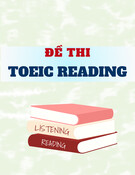

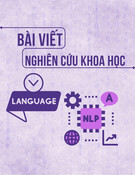







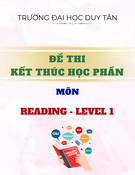
![Đề cương môn Tiếng Anh 1 [Chuẩn Nhất/Mới Nhất]](https://cdn.tailieu.vn/images/document/thumbnail/2025/20251130/cubabep141@gmail.com/135x160/51711764555685.jpg)








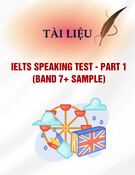

![Mẫu thư Tiếng Anh: Tài liệu [Mô tả chi tiết hơn về loại tài liệu hoặc mục đích sử dụng]](https://cdn.tailieu.vn/images/document/thumbnail/2025/20250814/vinhsannguyenphuc@gmail.com/135x160/71321755225259.jpg)
